Having a good chemistry in FIFA 13 Ultimate Team is extremely important.
Almost everybody knows that.
Although, there isn’t much information about how it works.
We went in a deep search and found everything there is to be discussed about this theme: what is chemistry, how you calculate it, what effect it has on the game, the managers’ role, what chemistry the substitutes have, etc.
In this vast guide we hope to clarify every player’s doubts and uncertainties. Experienced players or not.
What is Chemistry in FIFA Ultimate Team ?
The efficiency of our players on the pitch and of the team in general depends directly on several factors:
- The player’s level, attributes and characteristics;
- Chemistry;
- The Player’s Fitness;
- The Player’s Morale
The Chemistry takes a fundamental role on your team’s performance, so it can never be despised.
It evaluates the health of every relation in a club. In other words, the chemistry is a factor that helps the game play by interacting with the familiarity of the players with the club’s formation, positioning, the relation with the other players and the manager.
It’s easy to tell that a goalkeeper won’t play well if he’s put in the midfield. Also, it is comprehensible that a winger will not play at his best if there is one less team mate beside him than how he is adapted to play. It’s even easier to understand that a player’s performance will be superior if he is integrated in a squad full of team mates that he knows well, and with a good manager that has the same nationality as his.
In the end, that is what the chemistry does. Take all these situations, weigh how much they can benefit the performance of a team and transfer them to the four lines of this evaluation.
In general, the introduction for chemistry in FIFA 13 Ultimate Team is there to give more logic to the game and to make the building of a team more complex, challenging and diverse.
Chemistry in FIFA 13 Ultimate Team – Basic Concepts
The first idea that has to be present is that the chemistry is extremely important for the success of any team. In previous editions, EA have announced that “a bronze team with chemistry 100 can win without great difficulties a gold team without chemistry”. That is why it has to be taken seriously when you plan to start a new team. The team should be built around chemistry and not the opposite.
Another important concept, which is not always present, is that there are two kinds of chemistry: each player’s individual chemistry and the chemistry of the team.
Both influence the performance of the players on the pitch. The first one varies between 0 and 9 and the second between 0 and 100. The chemistry values can be viewed on the active squad menu, just like the image below demonstrates.
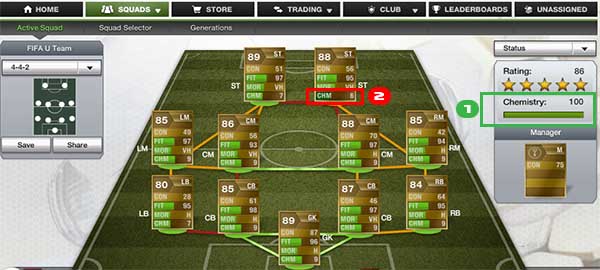
1- Chemistry of the Team; 2- Individual Chemistry
Any player should have as an objective building a team with the highest chemistry possible. The higher is the value, the better. The priority should be given to an individual chemistry close to or equal 9. If you can also get a team chemistry of 100, then you’ll be experiencing the best performance of your players.
The chemistry of the team depends exclusively of your choices. It’s higher or lower depending on the players you choose for the starting eleven, the manager you choose for the bench and the positioning and tactics of each one of the players. That way, it varies from match to match. It’s not possible to alter the chemistry of a player with time, for playing a certain number of matches or even for having performed several objectives.
What effect does the Chemistry have on the game ?
Now that you already know what the chemistry is, it’s time to know what it does in practice.
Most players know what to do to have a good chemistry and recognize its importance. But can’t explain what influence it has on the game. Some will say that the team’s performance is improved but it’s interesting to know what really changes when the ball is touched for the first time.
The chemistry interferes directly on the potential efficiency of the team during the match. More precisely, on the players’ attributes. That way, in the beginning of each match, the players’ attributes are directly affected by their individual chemistry and also the team’s.
Logically, a player doesn’t instantly have his speed doubled just because he’s surrounded by team mates that provide high chemistry. The chemistry in FIFA 13 Ultimate Team affects mainly the non-physical attributes.
Take a look at the list of the attributes that are slightly and more affected by the chemistry:
| MORE AFFECTED ATTRIBUTES | SLIGHTLY AFFECTED ATTRIBUTES |
| Agression | Acceleration |
| Composure | Agility |
| Positioning | Reactions |
| Tactic Conscience | Sprint Speed |
| Vision | Balance |
| Ball Control | Jumping |
| Dribbling | Stamina |
| Heading Accuracy | Strength |
| Finishing | |
| Crossing | |
| Passing | |
| Marking | |
| Interceptions | |
| Goalkeeper Attributes |
Maybe now you recognize better what effect the chemistry has. It’s not worth to spend thousands of coins to buy Ronaldo if his chemistry is zero. You will never experience his 90 finishing attribute.
The players’ attributes are corrected by the chemistry before the beginning of each match. It’s actually what happens in real life. A player’s performance will always be poor if he doesn’t get along with his team mates, if he plays out of his natural position or in a formation that may not be usual to him.
What influences the Chemistry in FIFA 13 Ultimate Team
The Chemistry measures several factors that are considered enough important to affect the performance of a player.
Here is what influences the Chemistry in FIFA 13 Ultimate Team:
- The Team’s Formation
- The Player’s preferred Formation
- The Positioning of a Player on the Team
- The Player’s natural Position
- The Nationality of the Players
- The Leagues where the Players play
- The Clubs where the Players play
- The Manager’s Nationality
- The Manager’s preferred Formation
- The Manager’s Level
It’s up to you to try to minimize the aspects that influence the chemistry negatively.
In order for us to comprehend better how all of this works, let’s group these factors in three big categories:
- The Players’ Preferences
- The Relation between the Players
- The Manager’s Characteristics
The Players’ Preferences
Normally, the players are habituated to play on a determined position and according to a pre-defined tactic. While many others can adapt themselves to similar positions and tactics. That is also what happens in FUT 13.

1- The player’s positioning on the team; 2- The player’s preferred position; 3 – The formation of the team; 4- The player’s preferred formation. (Click on the image in order to maximize it)
According to his positioning, a player may be in one of the following situations:
- Playing in his natural position
- Playing in a position that is very similar to his natural position
- Playing in a position that has some similarities to the natural position
- Playing in a position that is very different from the natural position
The natural position of a player is shown on his card. The position where he’s about to play is shown on the active squad menu. The first situation refers to when both positions are the same. That is the greatest situation to benefit the chemistry.
When a player is assigned to play in a strange position for himself, the chemistry is strongly affected. The goalkeepers is a good example of that. They can only play well on the goal, and are the only players that can’t get adapted to another position.
In order to know what positions a player can get adapted to, consult the tables from the FIFA 13 Ultimate Team calculation chapter.
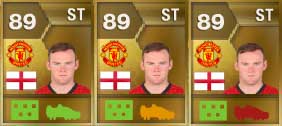
The good or bad positioning of a player on the pitch is graphically shown on his card through the boot’s color: green indicates playing on his natural position, orange indicates adaptation and red indicates that he’s playing on a position that is very different from the natural position.
According to his preferred formation, a player may be in one of the following situations:
- Playing with the same formation as his preferred formation
- Playing with a formation that is very similar to his preferred formation
- Playing with a formation that has some similarities to his preferred formation
- Playing with a formation that is very different from his preferred formation
The formation that the player is adapted to is shown on the card. The formation that he’s about to play with is shown on the active squad menu. The first situation refers to when both formations are the same. That is the greatest situation to benefit the chemistry.
When a player is assigned to play with a formation that is totally strange for him, the chemistry is strongly affected.
In order to know what formations a player can get adapted to, consult the tables from the FIFA 13 Ultimate Team calculation chapter.
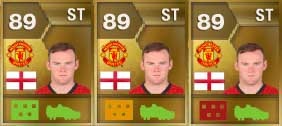
The good or bad formation for a player on the pitch is graphically shown on his card through the colour of the rectangle: green indicates playing with his preferred formation, orange indicates adaptation and red indicates that he’s playing with a formation that is very different from his preferred formation.
The Relation between the Players
When a club hires a player, it’s normal for him to have some adaptation issues. He doesn’t know his team mates, probably doesn’t even speak the same language as theirs and might not be familiar with the league. In FUT 13, that happens as well. The relation a player has with the team mates that surround him is strongly evaluated by the chemistry.
Each formation provides a defined connection that the players have between themselves. For example, it’s natural that a goalkeeper needs a stronger connection with the defenders than with the attackers.
These relations can be classified according to their intensity in:
- Absent
If the connection is between two players with different nationalities, different clubs and different leagues (Rooney and Messi, for example); - Weak
If the connection is between two players with the same nationality OR if they are from the same league but different clubs (Rooney and Aguero, for example); - Strong
If the connection is between two players with the same nationality and league but different clubs OR if it’s between two players from the same club (Rooney and Valencia, for example); - Hyper
If the connection is between two players with the same nationality and club (Rooney and Ashley Young, for example).
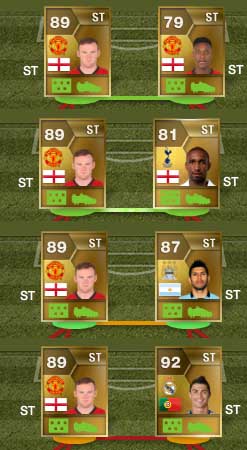
Graphic indication for the intensity of the connections. From top to bottom: hyper (green), strong (green), weak (orange) and absent (red).
The absent connections are the weakest ones and consequently the most penalising for the chemistry. The hyper ones are the strongest and the most rewarding connections for the chemistry.
Independently for the tactic of the team, a player must be linked to 2, 3, 4 or 5 team mates. The stronger these connections are, the higher will be the player’s individual chemistry.
That’s why most FUT 13 teams are built based in a league or in a nationality. This way it’s possible to eliminate the absent connections and guarantee a high chemistry.
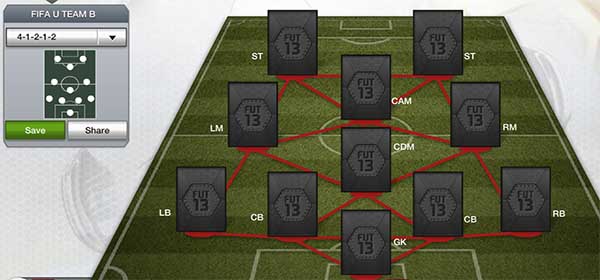
Taking the 4-1-2-1-2 tactic for an example, it’s possible to observe that the GK, the RB and the LB have only two players connected to themselves, the ST’s have three, the CB’s, the RM and the LM have four and the CDM and the CAM have five.
The Manager’s Characteristics
A manager is not just for choosing a tactic. He is the main piece for the maximization of the players’ potential. In FUT 13, the manager doesn’t influence the players’ individual chemistry, but he contributes a lot for the team’s chemistry.
There are three manager’s characteristics that will vary the team’s chemistry:
- His nationality
- His preferred formation
- His level
A manager that can be well comprehended has more success probabilities than one with worse relationships with the players. That’s why the chemistry is improved if the manager’s nationality is the same as most players’.
The nationalities of the players and managers are shown on the front of their cards.
Since it’s normally the manager the one who chooses the formation, it would make no sense that you’d want to choose a different formation for your team. If you do that, your chemistry will be damaged, of course.
According to his formation, a manager may be in one of the following situations:
- Chosen a familiar formation
- Chosen a different formation from the one he’s familiar to
The formation a manager is familiar to is shown on his card. The formation you chose for your team is shown on the active squad menu.
In the case of the managers, formation adaptation tables are not necessary because, unlike players, they can’t adapt themselves to other formations.
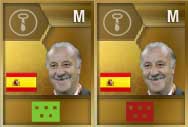
The correct or incorrect manager’s formation is graphically shown on his card through the rectangle’s colour: green if you’ve chosen the formation he’s familiar to and red if you’ve chosen a different formation.
A reputed manager has more chances to lead a team towards success than an unknown manager who coaches a lower division team. In FIFA 13 Ultimate Team this happens through the chemistry.
The higher is the manager’s level (gold, silver or bronze), the bigger will be his contribution for the team’s chemistry. And it doesn’t matter if he’s a rare manager or a normal one.
How to improve the Chemistry in FIFA 13 Ultimate Team
Fortunately it is possible to improve your team’s and your players’ chemistry.
In order to change the the players’ preferences, there is something that can be done to improve their individual chemistry: applying training cards, although this may cost big amounts of coins sometimes.
A formation modifier card, when applied to a player, changes his preferred formation. This means that, if a player doesn’t have the same formation as your squad’s, you can simply apply one of those consumables so that both have the same formation, improving your chemistry a lot.

Supposing a 4-4-2 formation in this example, the appliance of the training card in the middle made the player change his preferred formation from 3-4-1-2 (red) to 4-4-2 (green).
In that same way, if a player’s preferred position doesn’t match with the position he’s about to play, it’s possible to correct this situation with a position modifier card. These cards can only be applied with success if they indicate the current preferred position of the player and the one we want to change to.
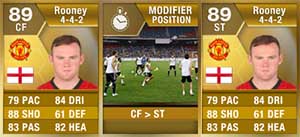
Supposing in this example that this specific formation doesn’t allow a CF, the appliance of the training card in the middle made the player change his position from CF (red) to ST (green).
It’s also possible to improve the relation between the players, but, in order to do that, it’s necessary to adjust our team.
Before we buy the players for our team, we should verify the intensity of the relations we will get. If they are sufficiently weak at a point that they can affect the chemistry, we should find players that can be well combined according to their nationality, league or club.
The intensity of the connection between two players is merely a graphic representation. It doesn’t mean that these players, in particular, play well with each other if their connection is green. What really counts for the individual chemistry is the summation of the intensities of the connections that a specific player has. Each player’s attributes are affected and not necessarily his relation with the team mates. So, any player plays the same way among all his team mates independently that he has different coloured connections.
A manager’s contribution for the chemistry can be maximized in the following ways:
- adding a gold manager to the team;
- synchronizing the manager’s formation with the squad’s formation, even if in order to do that you have to apply a specific manager training card, the same way you do with the players;
- choosing a manager whom nationality is predominant in the starting eleven.
- the squad’s formation
- the player’s preferred formation
- the player’s position
- the player’s preferred position
- the number of absent, weak, strong and hyper connections
- Step 1
- Step 2
- Step 3
- Inside the players’ preferences, the positioning weighs more on the chemistry than the formation
- The weight of a hyper connection surpasses three times the weight of a weak one
- The weight of a strong connection surpasses two times the weight of a weak one
- It’s almost always worth the investment for making the player be with the same position and formation as the squad’s
- The players underrate the importance of the chemistry
- The players overrate the chemistry
- he players don’t give the chemistry its correct balance
In the rest of this article, we’re going to show the advanced methods for improving the chemistry.
How the Chemistry is calculated in FIFA 13 Ultimate Team
The way the chemistry is calculated is probably the most well guarded secret in FIFA 13 Ultimate Team.
We came up with the idea of uncovering it.
The Chemistry Effect on the Game
In the first place it is important to know that the chemistry value that is used on the game is the weighted average of the individual chemistry (75%) and the squad’s chemistry (25%).
Unlike many people think, having individual chemistry values of nine is much more important than having a value of 100 on the squad’s chemistry display.
Even because the individual chemistry doesn’t only weights three quarters of the chemistry utilized on the game, but it also affects directly the chemistry of the squad, as we’re going to see next.
In other words, you can say that the attributes that each player starts a match with depend directly on the individual chemistry and partially on the squad’s chemistry.
Squad’s Chemistry Calculation
The squad’s chemistry varies between 0 and 100 and can be calculated with the following formula:
SC = IC + MC
where
SC is the squad’s chemistry
IC is the players’ individual chemistry (to be seen further)
MC is the manager’s contribution for the chemistry.
This formula allows the team’s chemistry to exceed 100. Although, in practical terms, any value that is superior to 100 has the same effect as 100.
On the other hand, the value the manager contributes for the chemistry varies between 0 and 21 and is calculate this way:
MC = F x L + N
where
F = 0 if the manager’s preferred formation and the squad’s do not match
F = 1 if the manager’s preferred formation and the squad’s match
L = 2 if he’s a bronze manager
L = 5 if he’s a silver manager
L = 10 if he’s a gold manager
N is the number of the starting eleven that have the same nationality as the manager.
Individual Chemistry Calculation
The player’s individual chemistry calculation method is very complex. We’ve tried to synthesize it in a simpler formula but there are some exceptions that deny its generalization.
In order to calculate a player’s individual chemistry you need to know:
Being aware of these informations, just follow these steps to discover a player’s individual chemistry value:
Look for the individual chemistry value on the first table. In order to do that you should choose how many connections the player has on the first column and the line that corresponds to the intensity of these connections. The chemistry value can be found when you cross that line with the column that corresponds to the specific formation and positioning situation.
A player in right formation and right position, with no links, has individual chemistry 6.
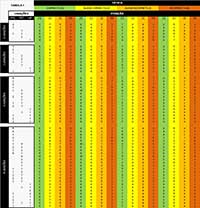
Table 1
If you had difficulties on selecting the position column on table 1, you can consult the second table. This one indicates in which position a player likes to play, if he can get adapted to another position or if he is playing with great difficulties. Just select the position line that is recorded on the player card and look at the position column in which the player was assigned to play.

Table 2
If you had difficulties selecting the formation column on table 1, you can consult the third table. This one indicates which formation a player likes to play with, if he can play adapted or with great difficulties. Just select the formation line that is recorded on the player card and look the formation column in which the player was assigned to play. Notice that this table is divided in four sections: goalkeepers, defenders, midfielders and attackers. It is that way because the players adapt themselves better to other formations according to their position. For example, a defender with a 4-4-2 preferred formation adapts himself better in a 4-3-3 formation than an attacker because the new formations maintains the 4 defenders playing style but not the 2 attackers.
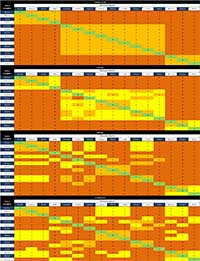
Table 3
FIFA 13 Ultimate Team Chemistry Calculation Example
In order leave no doubts, we’ll calculate a hypothetical squad’s chemistry.
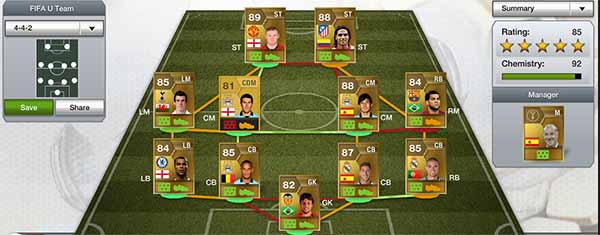
Click to maximize
Shall we start with the easiest part: the manager’s contribution for the chemistry.
We know that MC = T x L + N = 1 x 10 + 2 = 12
once T=1 because the manager’s preferred formation is the squad’s formation, L = 10 since it’s a gold manager and N = 2 because there are 2 Spanish players between the starting eleven.
About the individual chemistries, shall we limit ourselves to the Garteh Barry calculation.
Just by taking a look at the team we can see that Barry has a preferred formation that won’t get adapted to the squad’s. On the other hand, a CDM can play adapted as a CM since the boot’s colour is orange. Now we still need to know if the new position is very similar or if it has only a few similarities to his natural position. In order to do that we consulted the result of the cross between CDM (line) and CM (column) on table 2, which indicates that Barry can be very well adapted to the new position. About the intensity of the relations, Barry has 3 strong connections assigned as green (none of them is hyper since there is no English team mate from the same club as his) and one weak connection assigned as orange. By consulting the first table, you easily verify that Barry’s chemistry value is 7 (the third last column of the 4 connections 3-1-0 line).
If we do the math for the rest of the players we’re going to get the following individual chemistries: 7-5-9-7-9-3-9-7-9-6-9.
This way, the SC = (7 + 5 + 9 + 7 + 9 + 3 + 9 + 7 + 9 + 6 + 9) + 1 x 10 + 2 = 92.
This means that in general all of them will be able to play well, except for Pepe, Dani Alves and Falcão, whose individual chemistry values are below 7.
More importantly than knowing how to do the math in order to discover the chemistry is knowing how to take advantage of what is on table 1. If you carefully analyse it you can become an expert at this subject that is so important for a FUT 13 club’s success. Either at the team construction stage or at its improvement, it’s very important that we know what we need to do to maintain a high chemistry. Instead of reaching the chemistry we want with several tries, we can find out rigorously the pieces we should move to reach our objectives. It’s extremely important to know what weighs more on the chemistry calculation. Many times lots of coins are unnecessarily spent or are invested in players that we just wanted for an extra space on the team and not to bring benefits for the chemistry.
On a quick analysis to the table, it is concluded that:
These tables are also very useful in other situations, such as, for example, if you want to quickly know what happens if you buy a determined player for your team or how the chemistry will be affected if you change your squad’s formation.
If you take a good look, there are values on the table that are superior to 9. That happens because the individual chemistry calculation formula allows results between 0 and 11. In practice, a player with an individual chemistry value of 10 or 11 will play like one with 9, since graphically values that are superior to 9 are not presented. Also about the squad’s chemistry calculation, the values that are superior to 9 should be considered as being 9.
So why are there values that are superior to 9? The answer is simple. This way it’s possible that there are other ways to reach the maximum chemistry. If it weren’t like this, the combinations would be much lower and the diversity of squads with good chemistry would be poor.
The Substitutes’ Chemistry in FIFA 13 Ultimate Team
If you were alert to the previous chapter you should have noticed that the substitutes aren’t considered in the chemistry calculation. And much less the reserves.
The squad’s chemistry counts the summation of the starting eleven’s individual chemistries. Besides that, being on the bench, the substitutes don’t participate in the relations between the players. This means that the substitutes’ individual chemistry is zero and that their contribution for the squad’s chemistry is merely null.
Until now we’ve judged that this is very easy to understand. Although, a very important question arises: If we make a substitution, what will be the chemistry of the player who goes in and how is it going to affect the team’s chemistry ?
The answer is simpler than what some people would think. When we make a substitution, the player who goes in acquires the chemistry of the player who goes out and this way the team’s chemistry remains the same. The decisive moment for the chemistry definition is the starting eleven set-up. This means that, once the match has started, the chemistry values never change no matter what.
This is valid for all cases. Even if we put in a player that doesn’t have any relation with the others, if his preferred formation isn’t the same as the squad’s and even if he’s put to play in a completely different position.
For some people this can be seen as an opportunity. It becomes possible to use that player we always wanted but couldn’t use because he didn’t fit in our squad at all. We can also adapt players to other positions that usually don’t have quality choices.
It’s your chance to use Ronaldo as a centre forward, Ramires as a centre back or Bale side by side to Hazard without losing any chemistry points at all.
It’s also an opportunity to put Thiago Silva among a Barclays PL or a BBVA defence or to use Iker Casillas on the goal without having specific team mates that would increase his chemistry.
Although, everything has a cost. In this case, contracts will be spent. Besides that you’ll have to interrupt the match, preferably in the beginning, to make these substitutions, which would be quite boring.
The Chemistry in FIFA 13 Ultimate Team – Myth or Reality ?
If we thought that the chemistry in FIFA 13 Ultimate Team was just a myth, we wouldn’t have spent weeks investigating all this to bring you this article. Still, we thought it would be convenient to make a chapter about this theme since there is a considerable number of people who insist that there is no such thing as the chemistry in the game.
The best way for us to be certified about the influence of the chemistry on the game is playing several matches, ideally in the same condition, commanding a team with a high chemistry and another with a very low chemistry. We did this dozens of times and concluded that the chemistry in FIFA 13 Ultimate Team is actually real. Mathematically analysing the results we obtained, we concluded that when we played with a higher chemistry our development was very superior.
Many of the people who say there’s no such thing justify themselves with the fact that they have won several tournaments playing with teams with a very low chemistry. That’s not a justification. There are FIFA players that are good enough to win even with inferior teams, and so with low chemistries.
There are also the ones who consider that the chemistry should be abolished from FUT 13. We respect their opinion but consider that these people don’t comprehend how FUT works at all. Part of the joke of this game mode is the opportunity for us to create a team we can get identified with. If there was no chemistry, the challenge of building a team would be smaller and the diversity of teams would be reduced.
Common Errors on the Construction of a team with good Chemistry
There are three basic kinds of errors on the construction of a team with good chemistry in FIFA 13 Ultimate Team:
In the first situation, some players seem not to know the effect of the chemistry on the game or simply judge that it’s nothing but a myth. They’d rather build a team with the players they like independently for the chemistry.
What they don’t know is that their development can be superior if they slightly modify the team substituting a few players. There’s no need to give up on all their preferences.
Unless they are just starting FUT 13, those players can be easily identified for showing up with a chemistry that is lower than 60 (it’s not possible to see the opponent’s individual chemistry).
There are also those who put the chemistry ahead of everything. Extremisms are not necessary. If you follow all of our basic tips (see on next chapter) you can be in this group. In fact, everyone who has all the starting eleven with an individual chemistry of 9 and the team’s chemistry of 100 can be in this situation.
FUT 13 allows you to reach max chemistry in a bunch of ways. If we apply all these methods to reach a chemistry above the maximum value, we are certainly overrating this concept. The problem about this is that we can prejudice the quality or diversity of our team without taking any advantage of it.
That’s why it’s important to know how the chemistry works in FIFA 13 Ultimate Team. With this knowledge you can build teams that have only what’s really necessary to reach maximum chemistry. There’s no sense on trying to find more connections for a player that is connected to other four that already have a hyper connection.
This connection is already enough for a individual chemistry of 9. This management is not easy to be done but with practice you can build very interesting teams.
Follow our advanced tips in order to notice where you can optimize and how you can build hybrid teams.
The teams that are made up of exclusively players from the same league, club or nationality are almost always typical cases of “chemistry waste”.
The third group is probably the most common one: the ones who commit errors when building a team because of the lack of knowledge about how to do it.
This happens because many times most sources of information are not clear enough or even incorrect about what they say of this theme.
It’s a common sense between FUT players that having a good chemistry is having a chemistry of 100. Wrong. We can have a team chemistry of 100 in which two or three players have an individual chemistry of zero. This is not really a desired chemistry.
The idea that circulates is that the chemistry of the team is the main thing and the individual chemistry, that many don’t know about, has little importance. This is severely false. The individual chemistry is actually the one that weighs more on the attributes set up during the matches.
These players usually have team chemistries of 100 but unbalanced individual chemistries. Some with 9 and others less than 7.
So if we have individual chemistries of 9 for all the players, why would we worry about having a good manager if we already have a team chemistry of 99 and maximum individual chemistries? The question makes a lot of sense. It’s up to each one of us to decide if it’s worth spending manager contracts for a reward that is so insignificant. For us it is. We may have eleven players with brilliant chemistries but, once the squad’s rotation is the main piece for the success of any team that doesn’t want to be dependent to buying development cards, if we regularly need to put the reserves to play, it would be good to have a manager that gives us some chemistry points so we can have more player choices.
Basic tips on how to build a team with good Chemistry
If you’ve read what we wrote in this article, then you already know what to do to build a team with good chemistry. Just analyze the tables that calculate the chemistry to know what is really important.
For those who still feel a little disorientated, we’ll give a few tips about how to build a team with good chemistry in FIFA 13 Ultimate Team.
In the first place, it’s convenient for us to define what is this “good chemistry” thing. For us, a team with a very good chemistry is one that has all individual chemistries of 9 and a team chemistry of 100. It’s obvious that it’s not always possible to build our dream team full of individual chemistries of 9 but we should try to make them never lower than 7.
Unless you’re already an expert on this, the first step is to define what the players will have in common. We need them to have at least weak connections, since the most normal is for us to be based in a nationality or in a league to build our team.
A team that has players from the same league will have a very good chemistry, since the players are in their natural positions and have a preferred formation that is the same as the squad’s. In the same conditions, a team that has all players with the same nationality will have an even stronger potential chemistry because you can assign a manager with this same nationality that will give a +21 bonus to the chemistry of the team.
Don’t forget to save coins to invest on the chemistry. As it was already said, the individual chemistry component about the player’s preferences can be corrected if you have a budget for that. Having all players with the same tactic as the squad’s and playing in their natural positions represents half way gone.
One of the tricks for being able to build this team is knowing how to plan it before you start. Just having a general idea is not quite enough because you can start buying players and realize at the end that you don’t have enough connections
So, if you already chose what your players will have in common, it’s time to visualize what you intend to do for your team. Use our tables or a squad builder kind of application.
Beware that the tactic makes the way how the chemistry works vary. If you don’t have any preference you can even choose one for how it will fit in the chemistry of the team that you’re about to build.
Although it won’t affect the individual chemistries, you should always apply a manager to the team. Preferably a gold one with the squad’s tactic and the nationality of most players.
If you did everything we said here then we guarantee you that the chemistry of your team will be the maximum possible.
Advanced tips on how to build a good Chemistry
You may have already understood how everything works but an extra help is always welcome at the point that we idealize our team.
We give here a few tips for you to enjoy.
The hybrid squads are the most perfect we know. They allow us to go to other leagues and look for players to complete the positions we need. If built well, a hybrid team can join a good chemistry to a bigger variety of quality players. The one we built at MY FUT 13 is a good example of that.
But building a hybrid team with good chemistry may not be easy. The trick is to find specific key players that make the transition from one league to another or from a nationality to another.
One of the methods that can be used consists, if the formation allows us, in cutting the team on half. Each side is filled with players from one league or different nationalities.
To show you how well this method works, we tested a hybrid Serie A / BPL team. As you can see on the image below, only the central connections are absent. This won’t be a problem if there are strong connections among the other players.
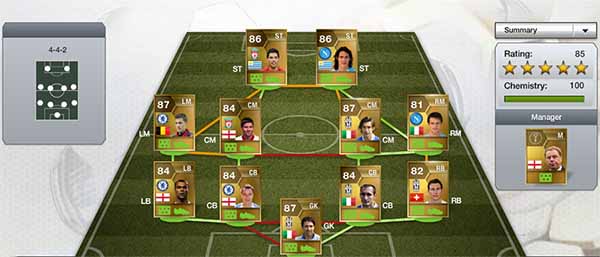
Hybrid Serie A/BPL team with a team chemistry of 100 and all individual chemistries of 9
There are some formations that are more favourable for building a hybrid team. It’s the case of the 3-5-2 and 4-3-2-1 formations, for having the key element that allows the separation of the players with different characteristics.
To show you how these tactics can be used for this, we built a team based on the BBVA League. Although, since Messi and Ronaldo are too expensive for most players, we decided to put a BPL attacking threesome that is full of qualities, too. In this case we chose David Silva to make the connection between the two leagues, but even if we chose another player for this, like Tévez for example, the only chemistry affected would be his own (from 9 to 7). The result is this fantastic team you can see on the image below.
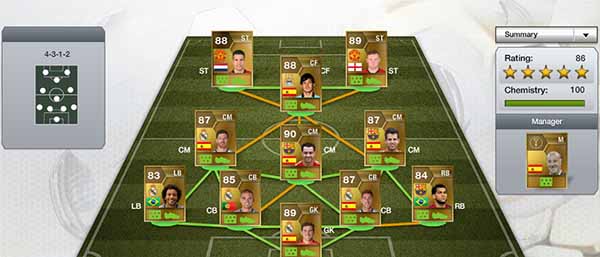
Hybrid BBVA/BPL team with a team chemistry of 100 and all individual chemistries of 9
The most experienced players can build a team that apparently presents few things in common between the players. In order to do that they have to know how to manage the chemistry perfectly. The easiest way to do that is investing for some hyper connections. In other words, most players will be full of absent connections except for one that, for being hyper, will guarantee the 9 points for the individual chemistry (this is valid for all players that have 4 or less connections).
In order to illustrate this technique, we built the team you can see on the image below. Despite most connections are absent, we were able to get the maximum chemistry possible. It is very easy to be done but rarely someone uses this technique. Just identify some players that are from the same club or have the same nationality and group them together two by two.
In this example, five leagues are represented. One of the advantages of this trick is that it allows us to recruit the most capable players without having to be restricted to one league or nationality.
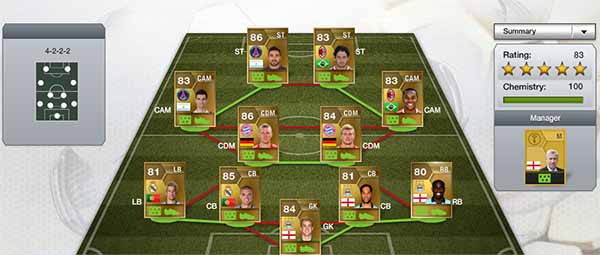
Varied Team with a team chemistry of 100 and all individual chemistries of 9
At last, we want to leave one tip for who likes to put players in their right position and tactic and want to know that, in an expedited way, if certain connections are enough to reach the 9 points of individual chemistry.
For any player to have the maximum chemistry he’ll just need to have a number of points equal or superior to the number of connections they have with their team mates. These points are counted by the following way: 1.0 for each weak connection, 2.5 for each strong connection and 4.0 for each hyper connection.
For example, on the last image, Pepe has 3 absent connections and 1 hyper. Since the summation of the points equals 4 and 4 is the number of connections he has, we easily conclude that Pepe has a maximum individual chemistry.
The EA and the Chemistry in FIFA 13 Ultimate Team
We’re completely independent and this is great for us to be able to compliment or criticize what we think is good or bad.
In a general way we think that EA makes a very good job. It’s true that there are server problems, items that get stuck on the trade pile, constant updates, etc… But when it comes to rules, FUT was a well made and implemented game. The chemistry system is a good example of that. It works and it has results.
But not everything makes sense on the chemistry of FIFA 13 Ultimate Team. We don’t get why EA makes it so much secrecy. Most part of the information we published in this article was based on intensive tests we made. It is not available for the common player that doesn’t want to spend hours trying to learn how the chemistry works.
The best example of what we’re saying is the way how the player’s preferences are assigned according to the colours that indicate intensity. The hyper and strong connections are both green-coloured which doesn’t allow the distinction between each one. Also the player’s position and tactic status is indicated by only one colour, orange, which doesn’t allow the distinction between those that a player will be able to get adapted to. It would be enough just to introduce one more colour, then we would be able to calculate the chemistry just by looking at two of the three tables in this article. We can only think that this was done intentionally so they could keep the chemistry secrets away from the players.
With this article we hope we were able to clarify everything about how the Chemistry works in FUT 13 and also unmasked myths and false ideas that circulate all over the FIFA players community.
The Chemistry in FUT 13 – Frequently Asked Questions (FAQ)
Q: What is Chemistry?
A: Chemistry is the factor that reverberates on the game the familiarity of the players with the club’s tactic, the positioning, their relation with the team mates and the manager. You can learn more about it here
Q: Does the Chemistry really exist or is it just a myth?
A: The Chemistry really exists. You can learn more about it here.
Q: Is it worth building a team with a high Chemistry?
A: It certainly is. A high chemistry means potential and a better performance for your players.
Q: What changes if my team has high or low chemistry?
A: Your team’s chemistry changes directly the players’s attributes on the pitch. Learn more here.
Q: I already have a chemistry of 100. That’s all that matters, right?
A: No. The players’ attributes on the pitch are modified by a component in which these 100 weigh 25% and the individual chemistry weighs 75%. Because of that, more than guaranteeing the 100 points for the team’s chemistry, it’s important to get the best individual chemistry (9) for the maximum number of players possible.
Q: I can’t get maximum chemistry for my team. What’s the minimum you recommend for me?
A: If for some reason you can’t get the maximum chemistry, you should try at least having 7 points of individual chemistry and 90 for the team’s chemistry.
Q: Can a player’s individual chemistry be superior to 9?
A: In theory, yes. Mathematically the individual chemistry varies between 0 and 11. In practice, the effect a superior value does is the same as 9.
Q: How does a manager influence the chemistry?
A: A manager only influences the team’s chemistry. And for that, his formation, nationality and level are important. Learn more here.
Q: What does the chemistry depend on?
A: In a general way the chemistry depends on the player’s preferences (formation and positioning), his relations with his team mates (nationality, league and club) and the manager’s characteristics (nationality, league, formation). Learn more here.
Q: Does a player that has bad connections with some team mates and good connections with others play differently with them?
A: No. The red connections are merely graphic indications. The way each player plays depends exclusively on his individual chemistry and the team’s chemistry. He’ll play the same way with everyone.
P: How is the chemistry calculated in FIFA 13 Ultimate Team?
R: The chemistry calculation method is not simple. Learn how it’s done here.
P: What’s the chemistry of a substitute?
R: Only the players that are assigned to play (the starting eleven) have chemistry. If a substitute comes in, his chemistry will be the same as the other player’s. Once the match starts, the team’s chemistry will not change. Learn more here.
Thanks to Pedro Henriques Coelho for the translation.
